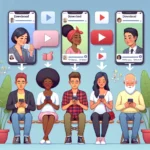TikTok, the vibrant and fast-paced social media platform, has taken the world by storm. From dance challenges to comedic skits, TikTok offers a unique blend of entertainment and creativity that has captured the hearts of millions. However, beneath its playful surface lies a growing concern about user privacy and data security. One of the most alarming claims is that TikTok might have the capability to track users’ keystrokes. This article will break down the security aspects of TikTok, examining the evidence, expert opinions, and steps you can take to protect your privacy.
The Keystroke Tracking Controversy
The idea that TikTok could track your keystrokes has been a hot topic of debate, especially since the app’s rapid rise in popularity. Keystroke tracking involves monitoring every key press made on a device, which can provide detailed insights into user behavior and potentially sensitive information. While TikTok has always maintained a stance of strong data protection, several reports and investigations have raised doubts about the app’s true capabilities.
Initial Reports and Concerns
In 2020, cybersecurity experts began to raise alarms over the possibility that TikTok might be collecting more data than it had initially disclosed. One of the primary concerns was the app’s access to device permissions, particularly those related to the keyboard. Critics argued that TikTok’s extensive permissions could allow it to track and record what users type, even outside the app.
The controversy gained traction when a report by the cybersecurity firm Check Point Research suggested that TikTok was requesting permissions to access sensitive features like the microphone and camera, which could theoretically be used to monitor keystrokes. Although TikTok denied these claims, the issue sparked widespread discussion and scrutiny from both users and regulators.
Technical Feasibility
To understand whether TikTok can track your keystrokes, it’s essential to delve into the technical aspects. Modern apps often request various permissions to function effectively, but not all permissions are created equal. For example, access to the microphone or camera can indeed be used to infer what users are typing, especially with advanced algorithms that analyze sound waves or visual cues.
However, tracking keystrokes directly is a more complex task. It typically requires specific permissions that most apps, including TikTok, do not explicitly request. For instance, on Android devices, an app needs the ‘BIND_INPUT_METHOD’ permission to interact with the keyboard, and on iOS, apps must be designated as a ‘keyboard extension.’ TikTok does not appear to request these permissions in its app manifest files.
Furthermore, tracking keystrokes would likely violate Apple’s and Google’s strict privacy policies. Both platforms have robust mechanisms to prevent such invasive practices. If TikTok were found to be tracking keystrokes without proper permissions, it could face significant legal and reputational consequences.
Expert Opinions and Investigations
The debate over TikTok’s ability to track keystrokes has drawn the attention of numerous cybersecurity experts and researchers. Let’s examine some of their findings:
Cybersecurity Firm Reports
Check Point Research, one of the leading cybersecurity firms, conducted an investigation into TikTok’s data collection practices. Their report highlighted that TikTok requests several permissions that could be used to gather sensitive information, including access to the microphone and camera. However, the report did not explicitly state that TikTok was tracking keystrokes, but rather suggested that the app had the potential to do so.
Another report by the cybersecurity company FireEye revealed that TikTok’s data collection methods were similar to other social media apps but noted that the scope and volume of data collected were unusually high. This raised questions about the app’s intentions and the potential misuse of user data.
Government Inquiries
Governments around the world, particularly in the United States, India, and the European Union, have launched inquiries into TikTok’s data security practices. The U.S. Federal Trade Commission (FTC) and the European Data Protection Board (EDPB) have both expressed concerns about the app’s data handling, with a focus on whether TikTok is collecting and transmitting user data to servers outside of the user’s country.
In 2021, the Indian government temporarily banned TikTok along with several other Chinese apps, citing national security concerns and the potential for data misuse. While the ban was later lifted, it underscored the seriousness of the issue and the need for transparency from app developers.
TikTok’s Official Stance
TikTok has consistently denied the allegations of keystroke tracking and other invasive data collection practices. The company emphasizes its commitment to user privacy and data security, stating that it adheres to strict guidelines set by app stores and regulatory bodies.
In a statement, a TikTok spokesperson said, We take the privacy and security of our users very seriously and work hard to protect their data. We do not collect keystroke data or any other form of sensitive information without explicit user consent.
TikTok has also taken steps to increase transparency, publishing detailed privacy policies and engaging with independent auditors to review its data practices. Despite these efforts, many users remain skeptical, especially given the app’s history and the broader context of data privacy concerns in the digital age.
Comparing TikTok with Other Social Media Apps
To better understand TikTok’s data collection practices, it’s helpful to compare them with other popular social media platforms. Apps like Facebook, Instagram, and Twitter also request a wide range of permissions, but they are subject to intense scrutiny and regulation, particularly in the wake of high-profile data breaches and privacy scandals.
Data Collection Practices
All major social media apps collect data to improve user experience and for targeted advertising. However, the extent and nature of this data collection vary. Facebook, for instance, has faced multiple lawsuits over its data practices, including the Cambridge Analytica scandal. Similarly, Twitter has been criticized for its handling of user data, particularly in terms of security vulnerabilities.
While TikTok’s data collection methods are not unique, the scale and speed at which the app gathers data have raised eyebrows. Some experts argue that TikTok’s aggressive data collection strategies are part of its business model, designed to provide highly personalized content and ads. Others suggest that the app’s data practices are no different from those of its competitors and that the controversy is fueled by geopolitical tensions.
Transparency and User Control
Transparency and user control are crucial in addressing data privacy concerns. Facebook and Instagram, for example, offer detailed privacy settings that allow users to manage their data sharing preferences. Twitter provides similar options and has implemented features like two-factor authentication (2FA) to enhance security.
TikTok has also introduced privacy controls in recent updates, allowing users to manage their account settings, restrict who can see their videos, and control data sharing. However, critics argue that these controls are not as comprehensive or user-friendly as those offered by other platforms. The app’s user interface and privacy policies are often criticized for being opaque and difficult to navigate.
Steps to Protect Your Privacy
Given the ongoing concerns about TikTok’s data practices, it’s important for users to take proactive steps to protect their privacy. Here are some practical tips:
- Review App Permissions: Regularly check the permissions granted to TikTok and other apps on your device. Disable unnecessary permissions, such as access to your microphone or camera, if you feel they are not essential for the app’s functionality.
- Use Strong Passwords: Ensure that your TikTok account and other online accounts are protected with strong, unique passwords. Consider using a password manager to generate and store complex passwords.
- Enable Two-Factor Authentication (2FA): Turn on 2FA for an added layer of security. This feature requires a second form of verification, such as a code sent to your phone, to log in to your account.
- Be Cautious with Personal Information: Avoid sharing sensitive personal information on TikTok or any other social media platform. This includes your address, financial details, and private conversations.
- Stay Informed: Keep up-to-date with the latest news and updates regarding TikTok’s data practices. Follow reputable cybersecurity sources and be aware of any changes in the app’s privacy policies.
- Consider Alternatives: If you are deeply concerned about your privacy, consider using alternative social media platforms that have a better reputation for data security and user control.
Real-World Examples and Case Studies
To illustrate the potential risks and how they can be mitigated, let’s look at a few real-world examples and case studies:
The Cambridge Analytica Scandal
The Cambridge Analytica scandal involving Facebook is a stark reminder of the dangers of lax data security practices. In 2018, it was revealed that the political consulting firm had harvested data from millions of Facebook users without their consent, using it to influence elections. This incident led to widespread outrage and calls for stricter data protection laws.
While TikTok has not been involved in a similar scandal, the incident highlights the importance of vigilance when it comes to data privacy. Users should be cautious about the permissions they grant to any app and regularly review their privacy settings.
The TikTok Privacy Audit
In response to growing concerns, TikTok commissioned an independent audit of its data practices. The audit, conducted by Deloitte, aimed to assess the app’s compliance with privacy regulations and identify areas for improvement. The results of the audit were generally positive, indicating that TikTok had implemented robust data protection measures.
However, the audit also highlighted several areas where TikTok could enhance its privacy protocols. These included improving user education about data collection, enhancing transparency in its privacy policies, and providing more granular control over data sharing.
Future Predictions and Trends
The future of TikTok’s data security practices is closely tied to broader trends in digital privacy and regulation. As user awareness and demand for data protection grow, social media platforms will need to adapt their practices to meet these expectations.
Regulatory Pressure
Regulatory bodies around the world are increasingly scrutinizing social media apps, including TikTok. The General Data Protection Regulation (GDPR) in the European Union and the California Consumer Privacy Act (CCPA) in the United States are just two examples of stringent privacy laws that could impact TikTok’s operations.
Future regulations may require apps to provide more transparent and user-friendly privacy controls. They could also impose harsher penalties for data breaches and unauthorized data collection. TikTok and other platforms will need to stay ahead of these trends to maintain user trust and avoid legal repercussions.
User Awareness and Activism
As users become more aware of data privacy issues, they are taking a more active role in protecting their information. The rise of digital literacy campaigns and privacy-focused apps is a testament to this growing awareness.
Users are also advocating for stronger data protection measures through social media, petitions, and community forums. This grassroots activism has the potential to drive change and hold companies accountable for their data practices.
Conclusion
The question of whether TikTok can track your keystrokes is complex and multifaceted. While there is no concrete evidence to suggest that TikTok is actively engaging in keystroke tracking, the app’s broad data collection practices and lack of transparency have raised legitimate concerns among users and experts alike.
Ultimately, the responsibility lies with both the app developers and the users. Developers must prioritize data security and user privacy, while users should be vigilant about the permissions they grant and the information they share. By staying informed and taking proactive steps, you can enjoy the creative and entertaining aspects of TikTok while minimizing the risks to your personal data.
Whether you continue to use TikTok or explore alternative platforms, the importance of data privacy cannot be overstated. In an era where personal information is increasingly valuable, it’s crucial to be mindful of how and where your data is being collected and used.





